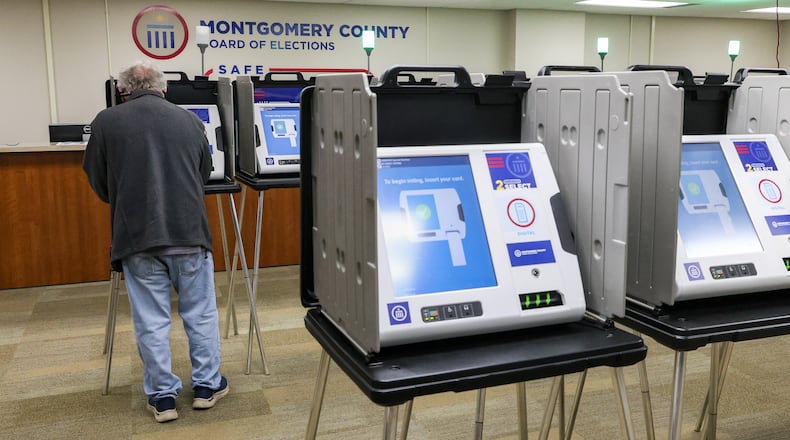This primary season saw very low early voter turnout so far in Montgomery, Greene, Warren and Miami counties.
Below are the major races and issues before voters May 6. Go to www.DaytonDailyNews.com/elections for previous coverage containing analysis of tax proposals and candidates’ platforms.
New school levies
Multiple mid-sized and large school districts are seeking tax increases.
• The Beavercreek school district is asking voters to approve the same 37-year, 4.9-mill bond issue that voters rejected in November. The money would pay to build a new high school and renovate other buildings, as school officials say they need to adjust for projected growth. The levy would cost a property owner $172 for each $100,000 in property valuation, said school officials.
• For Oakwood’s 33-year, 4.74-mill bond issue, school officials say 85% of the money would pay to update Smith and Harman elementary schools, plus some targeted projects at Oakwood High School/Junior High School and Lange School. The levy would cost taxpayers $165.90 a year per $100,000 in appraised home value, said school officials.
• In Huber Heights, school officials are asking for a $7.8 million, 6.9-mill levy that would cost $241.50 per $100,000 in appraised property values. School officials say the district is expected to begin deficit spending this year and would see large deficits in spending in the next few years.
• Northmont schools is seeking a 3.44-mill, $3.5 million, 10-year operating levy. The levy would cost homeowners $120 per $100,000 in property valuation a year. School officials say the new money is needed to maintain the district‘s current offerings.
• Mad River Schools voters will see a permanent, additional, 2.9 mills levy for permanent improvements. The same levy the district put on the ballot last year did not pass. The levy would cost taxpayers $102 annually for every $100,000 of appraised property value, according to school officials.
• Jefferson Twp. schools is asking for an additional, 1.5% earned income tax. The levy is expected to generate about $1.4 million per year and would cost someone earning $50,000 and living in the district $750 annually, according to the district. The funds would go toward operating expenses such as electricity, heat and salaries.
• Franklin Schools is seeking a five-year, additional, 6.301-mill levy for operations. Franklin has one of the lowest cash balances in the area. The district‘s treasurer said it has been 11 years since the last new-money levy passed. The levy would cost $220.54 a year for a house value appraised at $100,000.
• The Milton-Union school district is asking voters to approve an additional, five-year, 0.75% earned income tax. If this 0.75% income tax levy passes, it would cost someone with $50,000 in annual taxable income $375 in tax. Residents have rejected three different tax requests since November 2023.
Issue 2
All Ohio voters will see Issue 2 on their ballots. This ballot issue is a request from the state in the form of a constitutional amendment to issue up to $2.5 billion in bonds to help pay for infrastructure projects over the next decade.
The bonds, if approved by a simple majority of voters, would go toward the State Capital Improvement Program and could only be used on roads, bridges, water treatment and supply systems and solid waste disposal facilities, according to the legislature’s nonpartisan analysis.
The legislation that put Issue 2 on the ballot passed last year with support from Ohio lawmakers and various industry leaders, including the Ohio Chamber of Commerce and the County Engineers Association of Ohio.
City leadership
Dayton city commission: This May has a runoff election for Dayton city commission candidates, with five elections of this kind happening in the past 12 years. Five people are running for two available Dayton City Commission seats in 2025. The candidate who gets the fewest votes in the May 6 runoff election will be booted from the November ballot.
Candidates Darius Beckham, Jacob Davis, Valerie Duncan, Darryl Fairchild and Karen Wick all hope to make the cut.
The city commission is guaranteed to have at least one new face next year, because City Commissioner Shenise Turner-Sloss has jumped into the November mayor’s race.
Troy city council: Four candidates, all Republican, are seeking three at-large seats on Troy city council. In the race are incumbents Lynne Snee, Todd Severt and Susan Westfall, as well as newcomer Kay Friedly. Council members will be paid $9,207 annually beginning in January 2026.
The four candidates’ campaign focuses range from economic development, to affordable housing, community engagement and support for young people and young families.
Some Troy voters will also decide competitive races for two seats in the Republican primary. Voters will elect a council member from candidates Madison Hickman and incumbent Samuel Pierce in the 3rd Ward, and between Sherrie Foster and incumbent Jeffrey Schilling in the 6th Ward. No Democratic candidate filed for either seat, so the primary winners will be elected and begin their two-year terms in January.
Other tax issues
Montgomery, Greene and Warren County communities are seeking tax increases for public safety. This includes Sugarcreek Twp., where voters will decide on a 5-year, 1-mill additional fire and EMS levy. Franklin residents, too, will decide on fire services — their ballots will feature a continuing, 4.9-mill additional property tax levy.
In Montgomery County, German Twp. seeks a 10-year, 4-mill property tax levy for fire services.
Other tax issues:
* Harveysburg — Five-year, additional, 2.5 mills, for police service
* Troy-Miami County Public Library — Five-year, additional, 1 mill, for current expenses
* Bellbrook city — Permanent, additional 2.2 mills for public safety
Election Day voting: What to know
Voters can confirm their polling locations at VoterLookup.OhioSoS.gov. Polling locations will open across the state at 6:30 a.m. on Election Day and stay open until 7:30 p.m.
Voters wanting to cast a ballot in person should make sure they bring an unexpired photo ID to the polls to comply with Ohio’s voter ID law. Valid forms of identification include an Ohio driver’s license, a U.S. passport or passport card, a state of Ohio ID card, an interim ID form issued by the Ohio Bureau of Motor Vehicles, a U.S. military ID card, an Ohio National Guard ID card, or a U.S. Department of Veterans Affairs ID card.
All ID cards must be unexpired, have a photograph of the voter and include the voter’s name as it appears on the poll list. People who show up to vote in person who lack the proper ID are asked to vote provisionally. These voters must return to their election board office with a valid photo ID by May 10 to have their vote counted.
Absentee ballots sent by mail must be postmarked by Monday, May 5 to be counted. Absentee voters who have not turned in or mailed out their ballots by Monday have until 7:30 p.m. on Election Day to drop them off at their local election board office or ballot drop box.
About the Author

